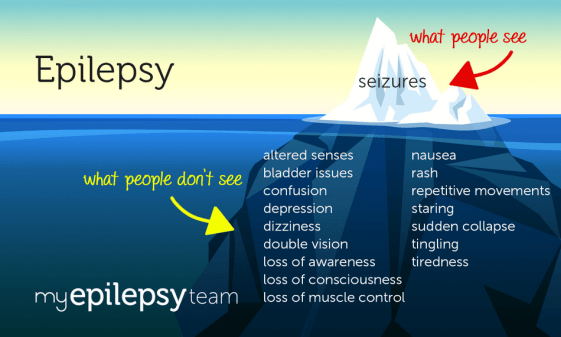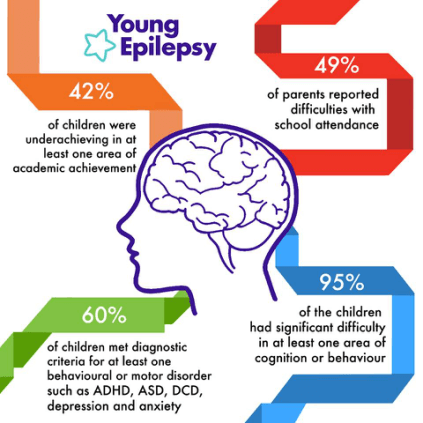Epilepsy (regardless of severity) creates life challenges and impacts on a person’s quality of life
- Epilepsy is the most complex and serious neurological condition and it affects at least 1–2 % of our population. This equates to over 40,000 New Zealanders and about 70 million people globally, with at least 80 % living in developing regions of the world. Epilepsy is the fourth-most common neurological condition after strokes, Alzheimer’s, and migraines and yet it is the least understood. It is a spectrum of disorders affecting a wide range of people.
- Throughout the ages, epilepsy has been a misunderstood condition and, according to a recent international report, the perceptions, fears and stigma still exist within parts of our community today. Although most people with epilepsy do live with near-normal lives, quite a few carry the burden of their condition daily in many different ways. For example, they may have difficulties in education, employment, financial constraints, finding safe and affordable housing, and social isolation.

- There are about 40 different types of epilepsy involving either the whole brain (generalised), or part of the brain (focal). Many people mistakenly see the so-called ‘convulsive seizure’ as being epilepsy whereas it is only one form of the condition. Epilepsy is therefore still very much a ‘hidden’ condition. There is a push by EWCT and similar organisations to bring epilepsy out from the shadows so that the needs of a person living with the condition are better understood by staff in government departments, in schools, places of higher learning, in employment, and in society more generally.
Fact: At least 60% of people with epilepsy have tonic clonic seizures, 20 % have focal impaired awareness seizures, 12 % have mixed tonic clonic and focal aware seizures and less than 5% have absence/myoclonic and other types. (Epilepsy Society UK)
- Between 58-70 % of people have good seizure control, mainly through using medications or by some other means (such as vagal nerve stimulation, diet, brain surgery, which all have potential side effects), but the remaining 42–30 % of people have absolutely none whatsoever. This means that a good section of people living with epilepsy have a diminished quality of life and can live in a condition of ‘amber alert’, which means, “When is my next seizure going to happen? Where will it happen? What will happen to me?”
-
Epilepsy is often difficult to diagnose since there is no specific diagnostic test, and this can cause anxiety, depression and stress for the person with seizures and for family/whanau members. There is a ripple effect when one person in the family has epilepsy, as it can impinge on every aspect of life and relationships.
Fact: In the UK, the misdiagnosis rate for epilepsy is between 21 and 30 %. (Epilepsy Society UK)
- Medications are used to treat (not cure) epilepsy. They have potential side effects, e.g. behavioural/personality/physical changes, nausea, fatigue, drowsiness, double vision. It is preferable for a person with epilepsy to take just one drug (monotherapy) but quite often he/she may be on many different medications (polytherapy) to control his/her seizures. A mix of drugs potentially means more side effects and it can take years to find the most suitable medication control available. Some people are ‘drug resistant’ and this can cause increased anxiety and stress, along with other possibilities of having seizures that are non-epileptic.
- Some medications, such as sodium valporate, have the potential to produce life-long, and debilitating side effects for children whose mothers take this particular drug whilst pregnant. Women who have epilepsy, and who are of child-bearing age, need to be carefully managed so that both the mother and child are protected from seizure risk and medication side effects. Children born with side effects caused by sodium valproate, in particular, have “foetal anti-convulsant syndrome”.
- Social isolation is a reality for some people living with epilepsy as they may be living under ‘amber alert’ conditions with little or no social support or transport. The person may also experience ostracisation by society, which further compounds that feeling of desperation and loneliness thus fuelling mental health issues.
- Having epilepsy can be seen as a barrier to employment. However, many people living with the condition can participate in a variety of jobs because their epilepsy does not affect their ability to work. On the other hand, those with ongoing epilepsy issues face higher levels of unemployment or underemployment. In all cases, people with the epilepsy label face fewer career options because having a seizure is perceived as a higher health and safety risk to all. The Human Rights Act is designed to help protect people with epilepsy from discrimination in employment.
- If people are affected by their epilepsy, or medications, whilst at school, or they have been bullied or teased, then they may end up leaving school with few or no qualifications. There are however, free courses available for young New Zealand citizens and so the possibility of participating in such courses offers hope for a positive future.
- Epilepsy is seen as an episodic event and therefore no real recognition is given to children requiring extra funding for support at school unless they have an additional condition such as ADHD, or a co-morbidity. Epilepsy does not necessarily hinder learning and skill development, but many children do experience learning issues which may include ongoing motor skills or cognitive functions, as well as a difficulty acquiring new skills or knowledge. Children can experience medication side effects just like adults and they can have ongoing memory and self-esteem issues.
Fact: More than one in five people with epilepsy have learning or intellectual disabilities. (Epilepsy Society UK)

- Receiving government or community-funded support can be problematic for adults if epilepsy continues to be considered as an episodic event by social service agencies. Some people are chronically affected by their epilepsy and therefore require a level of support that is given more readily to people with other medical conditions. Receiving any support can preclude a person with epilepsy simply because of the criteria for receiving help. Having epilepsy is a neurological condition and does not fit under the mental health, intellectual or physical health banners therefore reducing any quality of life for people chronically affected by their epilepsy.
- Absenteeism from school or work as a result of seizures can be a problem. Children will start missing out on valuable learning time and adults may start compromising sick-leave entitlements if they have them.
- Having epilepsy can be surprisingly costly with regular GP/pharmacy visits, the costs of personal and specialised alarms, ambulance costs, replacement costs of phones and wallets accidentally damaged or lost, repair costs for damage to homes (as the result of accidents resulting from a seizure), transport costs, and any additional support needed for a good quality of life.
-
There are no purpose-built residential/nursing care facilities in New Zealand to support those living with epilepsy. Some people are chronically affected by their condition. Epilepsy alone is not a mental health condition, and neither is it an intellectual or physical impairment. Rather, it is a neurological condition. Apart from a possible short-term stay in the hospital, there is nothing available to help those requiring careful and specialised epilepsy management -for example, introduction of the ketogenic diet, monitoring medication changes, or stabilising a person who has no seizure control.
-
Many homes need modifications to keep a person with epilepsy safe from injury or death, which adds to the cost, or restricts where one may be able to live. Other costs come in the form of damages to property caused by seizure activity.
-
There can be transport issues for those who have lost their driver’s licence as a result of a seizure. Loss of a licence can also mean a job loss which then has further ramifications on a person’s quality of life. (Clients have to be seizure-free for one year before being considered to have their driver licence restored.) If a person does not drive then he or she is limited to using public transport, taxi vouchers (if he/she qualifies), walking, or relying on the goodwill of others.
-
Epilepsy can potentially shorten the life of a person living with the condition by way of SUDEP (sudden unexpected death by epilepsy), status epilepticus (non- stop seizures), injuries, and suicide.
Fact: In the UK, approximately 42 % of the deaths per year relating to epilepsy are probably or potentially avoidable. (Epilepsy Society UK
-
We must recognise those who care for others with epilepsy, be it a parent, spouse or friend as they need support too. Carers are our unsung heroes who battle away in providing the level of care needed to sustain a positive quality of life for those living with epilepsy. Carers may help with recording seizures, managing medication routines, tending to seizures and the aftermath, attending appointments and advocating for the rights of their charges. The carer’s role can be stressful and fraught with problems as epilepsy is one of the most serious neurological conditions there is. Carers are an important part of the epilepsy care team.
-
To help people living with epilepsy and their family/whanau, the Epilepsy Waikato Charitable Trust (website address given below) has an adviser, who is specially trained in the epilepsy condition and the impacts of living with it. The role is diverse to cater for the complexity and age range of the people with epilepsy. The services provided include:
- Free confidential advice and support around the medical condition. Support may be given at medical and specialist appointments. The advisor is an important part of the ‘epilepsy team’ of professionals which include paediatricians, neurologists, pharmacists, and medical technicians who use EEG (electroencephalogram), MRI (magnetic resonance imaging), and other scans tohelp diagnose epilepsy.
- Advocacy in schools, employment and other services so that concerns are heard and met for the person living with epilepsy.
- Free epilepsy seminars to help break down that fear, stigma, and prejudice that exists in some quarters of society.
- A lending ear for when the going gets tough. The EWCT epilepsy advisor recognises that epilepsy can be a difficult condition to manage at times
- The Epilepsy Waikato Charitable Trust aim is to help people living with epilepsy. We are the leading epilepsy provider in the Waikato region.
